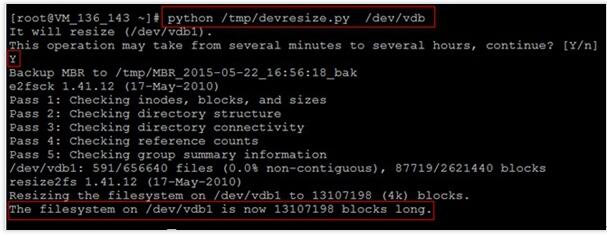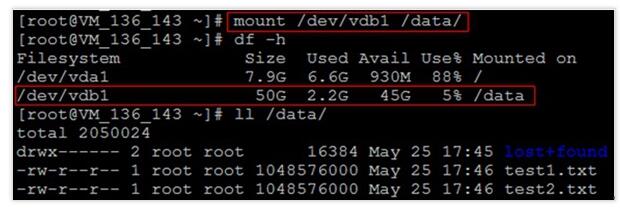扩容Linux文件系统
腾讯云 云硬盘扩容
https://cloud.tencent.com/product/cbs
https://cloud.tencent.com/document/product/362/6738
普通云硬盘(HDD Cloud Storage) 容量最大为16TB
高性能云硬盘(Premium Cloud Storage) 容量最大为4TB
SSD云硬盘(SSD Cloud Storage) 容量最大为4TB
单台虚拟机最多可挂载 10 块云盘,容量达 40TB。您可以轻松搭建大容量的文件系统,用于大数据、数据仓库、日志处理等业务。
请注意,由于MBR的限制,选择任何一种方式时,请保持任意分区的大小不超过2TB(若您扩容后的空间已经大于2TB则不可选择第二种方式。
一般系统分区方案
/boot 500M
/ 30G
SWAP 8G
/data 剩下空间
扩容分三步
1) 扩容实体云硬盘大小
2) 扩容分区
确定文件系统分区表形式
扩容分区
3) 扩容文件系统
GPT分区云硬盘扩容
umount 挂载点
parted [磁盘路径]
e2fsck -f /dev/vdb1
resize2fs /dev/vdb1
mount 分区路径 挂载点
# 具体命令 umount -lf /data parted /dev/vdb e2fsck -f /dev/vdb1 resize2fs /dev/vdb1 mount /dev/vdb1 /data 或 echo "/dev/vdb /data ext4 defaults,noatime,nodiratime 0 0" >>/etc/fstab mount -a
新空间增加到已有分区中(GPT分区格式)
查看数据盘信息
执行命令
parted 磁盘路径 print
确认云硬盘的容量变化。如在过程中收到如下提示,请输入Fix:


这里扩容后的云硬盘大小为107GB,已有分区的大小为10.7GB。
卸载已挂载数据盘
执行以下命令确认该云硬盘是否还有分区已挂载:
mount | grep '磁盘路径'

这里云硬盘上有一个分区(vdb1)挂载在/data上,需要将其解挂。
使用以下命令解挂:
umount 挂载点
本例中即执行umount /data进行卸载。
注:要将云硬盘上所有分区的文件系统都解挂,如vdb1、vdb2......
再次使用mount | grep '/dev/vdb'命令来确认此硬盘上所有分区的文件系统都已解挂。

数据盘分区
确认云硬盘所有分区均已卸载后,执行以下命令,将原分区删除并以同样的起始偏移新建一个分区:
parted [磁盘路径]
接下来输入unit s,将显示和操纵单位变成sector(默认为GB),输入print来查看分区信息,记住已有分区的Start值。
删除分区并新建后,Start值必须与这个相同,否则数据将会丢失。

执行以下命令删除原有分区:
rm [分区Number]
由上图可知云硬盘上有一个分区,Number号为“1”,执行rm 1,结果如下图:

输入mkpart primary [原分区起始扇区] 100%
新建一个主分区。
本例中使用mkpart primary 2048s 100%,此主分区从第2048个扇区开始(必须与删除之前的分区一致),100%表示此分区到磁盘的最末尾。
如果出现如图状态请输入Ignore:

再次输入print可发现新分区已经新建成功,输入quit,即可退出parted工具:

检查扩容后分区的文件系统
使用以下命令检查扩容后的分区:
e2fsck -f 分区路径
前述步骤中本例已新建了分区1,使用e2fsck -f /dev/vdb1进行操作。结果如下:

扩容文件系统
执行以下命令进行分区上文件系统的扩容操作:
resize2fs 分区路径

挂载新分区
执行以下命令挂载分区:
mount 分区路径 挂载点
这里通过mount /dev/vdb1 /data
手动挂载新分区,并使用df -h命令查看,出现以下信息说明挂载成功,即可以查看到数据盘了。

MBR分区云硬盘扩容
下面两种情况都可以选择使用自动扩容工具(devresize.py)进行扩容
1、原有的硬盘(数据盘)只有一个MBR主分区并制作了文件系统
2、原有的硬盘(数据盘)没有分区,直接在此硬盘上制作了文件系统
自动扩容工具适用于Linux操作系统,用于将扩容时新扩的云硬盘存储空间添加到已存在的文件系统中,扩容能够成功必须满足下面3个条件:
1、文件系统是ext2/ext3/ext4,并且只有一个主分区没有其他主分区和扩展分区
2、当前文件系统不能有错误
3、扩容后的磁盘大小不超过2TB
umount 挂载点
wget -O /tmp/devresize.py http://mirrors.tencentyun.com/install/virts/devresize.py 下载一键扩容工具
python /tmp/devresize.py 硬盘路径 云硬盘,而不是分区名
mount 分区路径 挂载点
# 具体命令 umount -lf /data wget -O /tmp/devresize.py http://mirrors.tencentyun.com/install/virts/devresize.py python /tmp/devresize.py /dev/vdb mount /dev/vdb1 /data 或 echo "/dev/vdb /data ext4 defaults,noatime,nodiratime 0 0" >>/etc/fstab mount -a
新空间增加到已有分区中(MBR分区格式)
卸载正在使用的硬盘分区
执行以下命令卸载分区:
umount 挂载点

下载一键扩容工具
执行以下命令下载工具:
wget -O /tmp/devresize.py http://mirrors.tencentyun.com/install/virts/devresize.py
执行扩容工具
执行以下命令进行扩容:
python /tmp/devresize.py 硬盘路径
请注意,这里硬盘路径是需要扩容的云硬盘,而不是分区名。若您的文件系统在vdb1上,则应执行
python /tmp/devresize.py /dev/vdb

若输出“The filesystem on /dev/vdb1 is now XXXXX blocks long.“则表示扩容成功。
重新挂载扩容后的分区
执行以下命令挂载扩容后的分区:
mount 分区路径 挂载点
并通过以下命令查看扩容后的分区容量:
df -h
这里通过mount /dev/vdb1 /data命令手动挂载扩容后的分区(如果原先是没有分区的,执行mount /dev/vdb /data),
用df -h命令查看,出现以下信息说明挂载成功,即可以查看到数据盘了:

再执行ll /data命令,可以查看到,扩容后原分区的数据没有丢失,新增加的存储空间已经扩容到文件系统中。
devresize.py
#!/usr/bin/env python # coding: utf-8 # FileName: devresize.py """ It only handle the following two situations: 1. There is only one primary partiion in the disk with a format of ext2/3/4; 2. The disk is raw with a file system whose format is ext2/3/4. """ import struct import array import fcntl import time import sys import os import glob import logging BLKSSZGET = 0x1268 BLKGETSIZE = 0x1260 BLKRRPART = 0x125f BLKGETSIZE64 = 0x80041272 logger = None def read_ub(data): return struct.unpack('B', data[0])[0] def read_us(data): return struct.unpack('<H', data[0:2])[0] def read_ui(data): return struct.unpack('<I', data[0:4])[0] def read_ul(data): return struct.unpack('<Q', data[0:8])[0] def init_log(): global logger log_file = 'devresize.log' fmt_file = '%(asctime)s - [%(levelname)-5.5s]- %(filename)s:%(lineno)s - %(message)s' fmt_stream = '[%(levelname)s] - %(message)s' logger = logging.getLogger('devresize') logger.setLevel(logging.DEBUG) file_handler = logging.FileHandler(log_file) file_handler.setLevel(logging.DEBUG) file_handler.setFormatter(logging.Formatter(fmt_file)) logger.addHandler(file_handler) stream_handler = logging.StreamHandler() stream_handler.setLevel(logging.INFO) stream_handler.setFormatter(logging.Formatter(fmt_stream)) logger.addHandler(stream_handler) class PartitionEntry(object): PartitionTypes = { 0x05: "Microsoft Extended", 0x83: "Linux", 0x85: "Linux Extended" } def __init__(self, data): self.data = data self.boot_sig = data[0] self.start_head, self.start_sector, self.start_cylinder = ( PartitionEntry.get_hsc(data[1:1 + 3])) self.partition_type = read_ub(data[4]) self.end_head, self.end_sector, self.end_cylinder = ( PartitionEntry.get_hsc(data[5:5 + 3])) self.start_lba = read_ui(data[8:8 + 4]) self.sector_num = read_ui(data[12:12 + 4]) self.partition_type_name = PartitionEntry.PartitionTypes.get(self.partition_type, "other") @staticmethod def get_hsc(data): h, s, c = struct.unpack('BBB', data[0:3]) c = (c | ((s & 0xC0) << 2)) s = (s & 0x3F) return h, s, c @staticmethod def cal_hsc(sector, hh, ss): s = sector % ss + 1 sector /= ss h = sector % hh sector /= hh c = sector & 0xFF s |= (sector >> 2) & 0xC0 return h, s, c def vaild_type(self): return self.partition_type in self.PartitionTypes def isprimary(self): return self.partition_type == 0x83 def __str__(self): if not self.vaild_type(): print "%x" % self.partition_type return "This isn't a Linux Partition!" return """ Start h,s,c: %u %u %u End h,s,c: %u %u %u Partition Type Name:%s Start LBA: %u Sector Number: %u """ % (self.start_head, self.start_sector, self.start_cylinder, self.end_head, self.end_sector, self.end_cylinder, self.partition_type_name, self.start_lba, self.sector_num) class MBR(object): def __init__(self, data): self.data = data self.boot_code = data[:446] self.mbr_sig = data[510:512] if self.check_mbr_sig(): self.partitions = ([PartitionEntry(data[446 + 16 * i:446 + 16 * (i + 1)]) for i in range(0, 4)]) else: self.partitions = None if self.partitions is not None: self.vaild_part_num = len(filter(lambda x: x.vaild_type(), self.partitions)) else: self.vaild_part_num = 0 self.device_heads = 0 self.device_sectors = 0 self.cal_device_hs() def cal_device_hs(self): if self.partitions is not None and self.vaild_part_num == 1: self.device_heads = self.partitions[0].end_head + 1 self.device_sectors = self.partitions[0].end_sector & 0x3F def check_mbr_sig(self): mbr_sig = read_us(self.mbr_sig) if mbr_sig == 0xAA55: return True else: return False def get_device_size(fd): buf = array.array('c', [chr(0)] * 8) fcntl.ioctl(fd, BLKSSZGET, buf, True) logical_sector_size = read_ul(buf) buf = array.array('c', [chr(0)] * 8) try: fcntl.ioctl(fd, BLKGETSIZE, buf, True) device_size = read_ul(buf) * 512 except IOError: fcntl.ioctl(fd, BLKGETSIZE64, buf, True) device_size = read_ul(buf) device_sector_number = device_size / logical_sector_size logger.debug( '''device_size:%d device_sector_number:%d logical_sector_size:%d''' % (device_size, device_sector_number, logical_sector_size)) return device_size, device_sector_number, logical_sector_size def backup_mbr(data): bak_name = '/tmp/MBR_%s_bak' % time.strftime("%Y-%m-%d_%X", time.localtime()) bak_file = open(bak_name, 'w') bak_file.write(data) bak_file.close() logger.info("Backup MBR to %s" % bak_name) return bak_name def is_first_start(): bak_file_list = glob.glob('/tmp/MBR_%s*bak' % time.strftime("%Y-%m-%d", time.localtime())) return len(bak_file_list) == 0 def cal_new_part(part_data, mbr, start_lab, new_end): device_heads, device_sectors = mbr.device_heads, mbr.device_sectors new_partition_sector_num = new_end - start_lab + 1 begin_h, begin_s, begin_c = PartitionEntry.cal_hsc(start_lab, device_heads, device_sectors) end_h, end_s, end_c = PartitionEntry.cal_hsc(new_end, device_heads, device_sectors) new_part_data = list(part_data[:]) new_part_data[1:1 + 3] = list(struct.pack('BBB', begin_h, begin_s, begin_c)) new_part_data[5:5 + 3] = list(struct.pack('BBB', end_h, end_s, end_c)) new_part_data[0xc:] = list( struct.pack('BBBB', (new_partition_sector_num & 0xff), ((new_partition_sector_num >> 8) & 0xff), ((new_partition_sector_num >> 16) & 0xff), ((new_partition_sector_num >> 24) & 0xff))) logger.debug(""" Start h,s,c: %u %u %u End h,s,c: %u %u %u Partition Type Name:%s Start LBA: %u Sector Number: %u """ % (begin_h, begin_s, begin_c, end_h, end_s, end_c, mbr.partitions[0].partition_type_name, mbr.partitions[0].start_lba, new_partition_sector_num)) return new_part_data # filesystem type must be ext2/3/4 def check_format(dev): blkid_ret = os.popen('blkid %s' % dev) s = blkid_ret.read() if blkid_ret.close() is not None: return False return True in [i in s for i in ['ext2', 'ext3', 'ext4']] def part_probe(fd): logger.debug('part_probe') fd.flush() fcntl.ioctl(fd, BLKRRPART) def resize2fs(dev): ret = os.system('e2fsck -f %s' % dev) logger.debug('e2fsck ret is %d' % ret) if ret not in (0, 1): raise RuntimeError('e2fsck failed!!') if ret == 1: logger.info('File system errors corrected') ret = os.system('resize2fs %s' % dev) logger.debug('resize2fs ret is %d' % ret) if ret != 0: raise RuntimeError('resize2fs failed!!') def check_mount(target_dev): # target_dev is mounted! return os.system('mount | grep "%s " > /dev/null' % target_dev) == 0 def write_mbr(fd, mbr_data): fd.seek(0) fd.write(mbr_data) part_probe(fd) fd.close() time.sleep(1) def check_arg(device): return not device[-1].isdigit() def get_disk_path(partation_name): for i, ch in enumerate(os.path.basename(partation_name)[::-1]): if not ch.isdigit(): return partation_name[::-1][i::][::-1] logger.error("invalid para %s" % partation_name) raise Exception("invalid para %s" % partation_name) def main(): if len(sys.argv) < 2: print "Usage: %s block_device" % sys.argv[0] sys.exit(1) init_log() logger.debug("user input:%s" % ' '.join(sys.argv)) device = sys.argv[1] if not check_arg(device): logger.error("The argument should be a whole disk not a partation!like %s" % get_disk_path(device)) sys.exit(1) if not os.access(device, os.W_OK): logger.error("Permission denied") sys.exit(1) fd = open(device, 'r+') data = fd.read(512) mbr = MBR(data) device_size, device_sector_number, logical_sector_size = get_device_size(fd) if mbr.vaild_part_num > 1: logger.error("Disk %s have multi partition." % device) sys.exit(1) target_partition = '' resize_part_flag = True if mbr.vaild_part_num == 1: # only one partition, which is the primary partition if not mbr.partitions[0].isprimary(): # and the filesystem type is ext2/3/4. logger.error("Must be primary partition.") resize_part_flag = True if device[-1].isdigit(): target_partition = device + 'p1' # ex: /dev/nbd0 -> /dev/nbd0p1 else: target_partition = device + '1' # ex: /dev/vdb -> /dev/vdb1 logger.debug(mbr.partitions[0]) if mbr.vaild_part_num == 0: # no partition but whole disk is ext2/3/4 resize_part_flag = False target_partition = device logger.debug('target_partition:%s' % target_partition) if not check_format(target_partition): logger.error("Only can process ext2/3/4.") sys.exit(1) if check_mount(target_partition): logger.error("Target device %s must be unmounted." % target_partition) sys.exit(1) logger.info("It will resize (%s). " "This operation may take from several minutes to several hours, continue? [Y/n]" % target_partition) user_input = raw_input() if user_input.lower() != 'y' and user_input != '': logger.warn("User input neither 'y' nor '[Enter]',exit.") sys.exit(1) if not is_first_start(): logger.warn('We find some MBR backup file in /tmp,maybe the MBR is already changed,' 'do you want to just resize the filesystem? [Y/n]') user_input = raw_input() if user_input.lower() == 'y' or user_input == '': resize_part_flag = False if resize_part_flag: logger.debug("Begin to change the partation") if (mbr.partitions[0].start_lba + mbr.partitions[0].sector_num) == device_sector_number: logger.error("No free sectors available.") sys.exit(1) if mbr.partitions[0].sector_num > 0xFFFFFFFF * 512 / logical_sector_size: logger.error("Can't process the partition which have exceeded 2TB.") sys.exit(1) new_start_sector = mbr.partitions[0].start_lba new_end_sector = device_sector_number - 1 if (new_end_sector - new_start_sector + 1) * logical_sector_size > 0xFFFFFFFF * 512: user_input = raw_input("The size of this disk is %.2fTB (%d bytes). " "But DOS partition table format can not be used on drives for volumes larger than 2TB (2199023255040 bytes). " "Do you want to resize (%s) to 2TB?[Y/n]" % (round(device_size / 1024.0 / 1024 / 1024 / 1024, 2), device_size, target_partition)) if user_input.lower() != 'y' and user_input != '': logger.warn("User input neither 'y' nor '[Enter]',exit.") sys.exit(1) new_end_sector = 0xFFFFFFFF * 512 / logical_sector_size + new_start_sector - 1 new_mbr_data = list(data)[:] new_mbr_data[446:446 + 16] = cal_new_part(data[446:446 + 16], mbr, new_start_sector, new_end_sector) backup_mbr(data) try: if resize_part_flag: write_mbr(fd, ''.join(new_mbr_data)) resize2fs(target_partition) except Exception, e: logger.error(e) logger.error('Some error occurred!!Maybe you should call the customer service staff.') if __name__ == '__main__': main()
腾讯云主机做raid
https://cloud.tencent.com/document/product/362/2932
都是系统层面的raid
windows主机
windows2012R2:使用系统自带磁盘管理器里的 ,新建镜像卷功能,把两个弹性云硬盘连接到云主机,然后新建镜像卷做raid1
Linux主机
centos6:Linux内核提供了md模块在底层管理RAID设备,我们可以使用mdadm工具来调用md模块。安装mdadm(以CentOS为例)
f